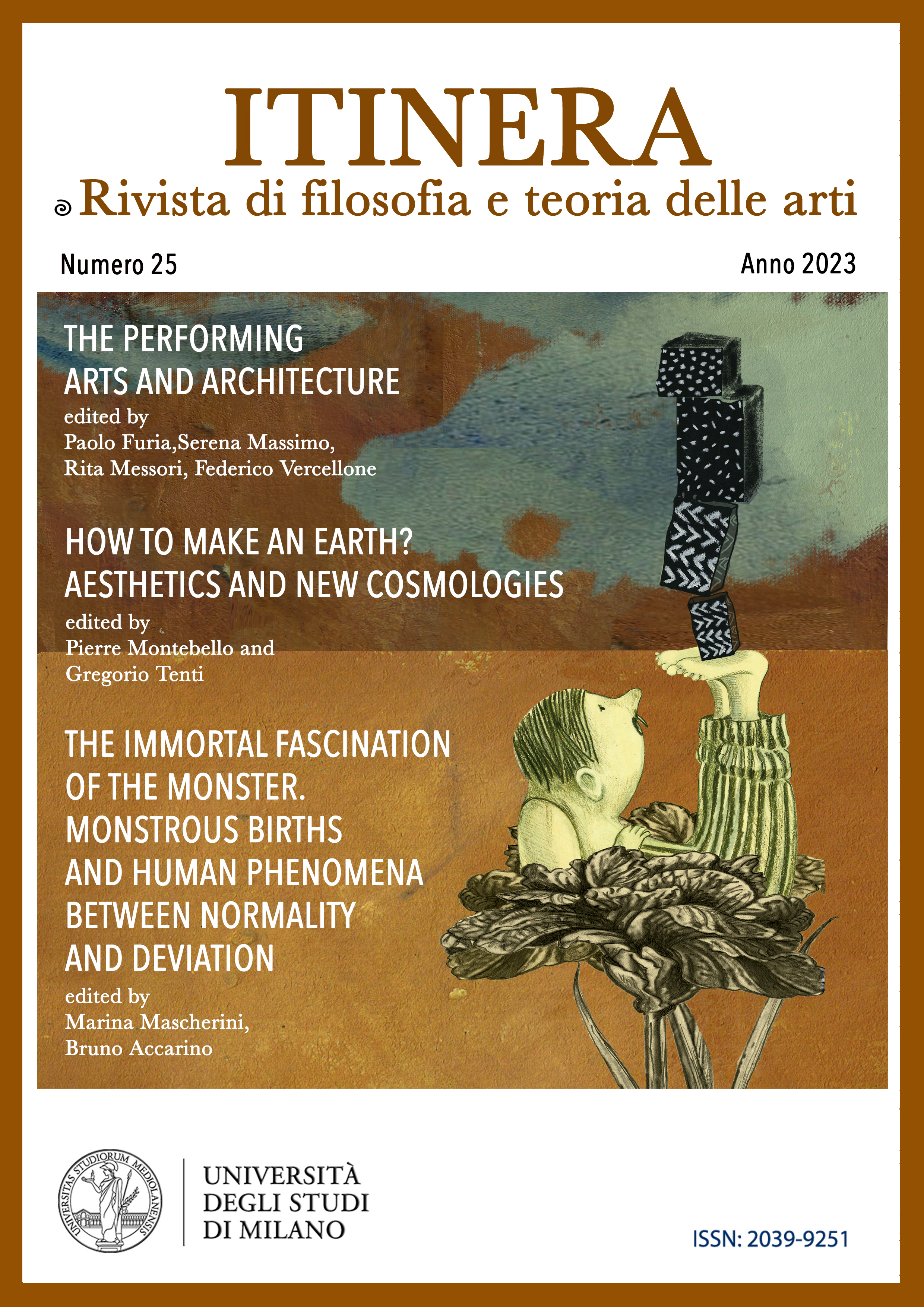The Performative Power of Architecture. Anna’s Halprin’s Dance Deck as the Source of her “Transformational Dance”
DOI:
https://doi.org/10.54103/2039-9251/20801Abstract
This paper aims at investigating the intertwining between dance and architecture by taking as a case study the dance of Anna Halprin (1920-2021), whose character of rupture with modern dance contributes to the questioning of dance codes and conventions that essentially informs western contemporary dance. After a presentation of Anna’s intention to strengthen dance’s function of transforming people’s lives by restoring the original link between dance and nature, we will show how this intention leverages the ritual, essentially performative dimension of dancing. After underlining, with Alberto Pérez-Gómez, the original link between architecture and ritual understood as an action of displaying – rather than imposing – a pre-existing meaning and opening up to its unfolding, we will emphasise how the outdoor dance studio built for Anna by her husband, the urban architect and landscape planner Lawrence Halprin (1916-2009), invites to take up this action. The notion of lived corporeity developed by Hermann Schmitz in his “New Phenomenology” (1965), and that of “atmospheric affordances” (Griffero 2013), will allow us to show that dancing on this studio triggers an “exploratory” attitude of unprecedented ways of moving and interacting with one’s own surroundings by virtue of the everchanging interaction between architectural, meteorological and natural elements provided by this space. Finally, the conception of “material performativity” (Dalmasso 2020) will bring out that the transformative capacity of dance derives precisely from its ability to grasp and differentially decline the performative process of mutual constitution and influence between human and non-human entities.
Riferimenti bibliografici
Austin, J.L., How to Do Things with Words, Oxford University Press, Oxford 1962.
Böhme, G., Atmospheres: New Perspectives for Achitecture and Design, in P. Tidwell (2014c), Architecture and Atmosphere, Tapo Wirkkala-Ru Bryk Foundation, Espoo 2013, pp. 6-13, p. 11.
Coole, D., Froster, S., New Materialisms. Ontology, Agency, and Politics, Duke University Press, Durham-L 2010.
Dalmasso, A.C., Things That Matter. Agency and Performativity, in “Aisthesis” 13(1), pp. 155-168. DOI: 10.13128/Aisthesis-10704.
De Matteis, F., Vita nello spazio. Sull’esperienza affettiva dell’architettura, Mimesis, Milano-Udine 2019.
Fischer-Lichte, E. Ästhetik des Performativen (2004), eng. transl. The Transformative Power of Performance. A New Aesthetics, Routledge, London-New York 2008.
Griffero, T., Atmospheres. Aesthetics of Emotional Spaces (2010), Routledge, London 2014a.
Giffero, T., Estetica patica. Appunti per un’atmosferologia neofenomenologica, in “Studi diestetica”, 12 (2014b), pp. 161-183.
Griffero, T., Architectural Affordances: The AtmosphericAuthority of Spaces, in P. Tidwell (2014c), Architecture and Atmosphere, Tapo Wirkkala-Ru Bryk Foundation, Espoo 2013, pp. 15-48.
Griffero, T., Atmospheres and Felt-bodily Resonance, in “Studi di estetica”, 1 (2016), pp. 1-41.
Griffero, T., Quasi-Things. The Paradigm of Amospheres (2013), Suny Press, Albany 2017.
Griffero, T., Places, Affordances, Atmospheres. A Pathic Aesthetics, Routledge, London-New York 2020a.
Griffero, T., Better to Be in Tune. Between Resonance and Responsivity, in “Studi di estetica”, 2 (2020a), pp. 93-118.
Griffero, T., They Are There to be Perceived: Affordances and Armospheres, in Z. Djebbara (ed.), Affordances in Everyday Life. A Multidisciplinary Collection of Essays, Springer, Cham 2022, pp. 85-95.
Halprin, A., Moving Toward Life: Five Decades of Transformational Dance, Wesleyan University Press, Middletown 1995.
Louppe, L., À propos de The Mind is a Muscle d’Yvonne Rainer, in “Le Travail de l’art”,1 (1997). 1997.
Louppe, L., Poétique de la danse contemporaine (1997), Contredanse, Bruxelles 2004.
Merriman, P., Architecture/Dance: Choreographing and Inhabiting Spaces with Anna and Lawrence Halprin, “Cultural Geographies”, 17(4) (2010), pp. 427-449.
Metta, A., Passo A due. Paesaggi corpo a corpo, in A. Metta, B. Di Donato, Anna e Lawrence Halprin. Paesaggi e coreografie del quotidiano, Libria, Melfi 2014, pp. 45-67.
Pousin, F., De la chorégraphie à l’architecture du paysage: noter pour concevoir, in “Les carnets du paysage. Actes sud et l’école nationale supérieure du paysage”, 13/14 (2007), pp. 23-47.
Pérez-Gómez, A., Architecture as a Performing Art: Two Analogical Reflections, in M. Feuerstein, G. Read (eds.), Architecture as a Performing Art, Ashgate Publishing Limited, Farnham, Surrey-Burlington 2013, pp. 15-25.
Ross, J., Anna Halprin. Experience as Dance, University of California Press, Berkley-Los Angeles-London 2007.
Schechner, R., Performance Studies. An Introduction (2002), Routledge, London-New York 2013,
Schmitz, H., New Phenomenology. A Brief Introduction (2011), Mimesis International, Milan 2019.
Schorn, U., The Life/Art Process, in G. Wittmann, U. Schorn, R. Land (eds.), Anna Halprin. Dance-Process-Form, Jessica Kingsley Publishers, London-Philadelphia 2015, pp. 57-92.
Tiberghien, G.A., Le paysage est une traversée, Paranthèses, Marseille 2020.
Wasserman, J., A World in Motion: The Creative Synergy of Lawrence and Anna Halprin, “Landscape Journal”, 1/2 (2012), pp. 33-52.
Wittman, G., The Life and Work of Anna Halprin, in G. Wittmann, U. Schorn, R. Land (eds.), Anna Halprin. Dance-Process-Form, Jessica Kingsley Publishers, London-Philadelphia 2015, pp. 15-56.
Worth, L., Poynor, H., Anna Halprin, Routledge, London-New York, 2012.
Sitography
https://www.youtube.com/watch?v=e2diNM6EAc0&t=86s.
https://www.youtube.com/watch?v=ZVKGT5V_sD8&ab_channel=Jacob%27sPillow.
https://www.youtube.com/watch?v=3z3-fcYa4Fs&ab_channel=TheCulturalLandscapeFoundation.
Dowloads
Pubblicato
Fascicolo
Sezione
Licenza
Copyright (c) 2023 Serena Massimo

Questo lavoro è fornito con la licenza Creative Commons Attribuzione - Condividi allo stesso modo 4.0.
Gli autori che pubblicano su questa rivista accettano le seguenti condizioni:
1. Gli autori mantengono i diritti sulla loro opera e cedono alla rivista il diritto di prima pubblicazione dell'opera, contemporaneamente licenziata sotto una Licenza Creative Commons - Attribuzione - Condividi allo stesso modo 4.0 internazionale che permette ad altri di condividere l'opera indicando la paternità intellettuale e la prima pubblicazione su questa rivista.
2. Gli autori possono aderire ad altri accordi di licenza non esclusiva per la distribuzione della versione dell'opera pubblicata (es. depositarla in un archivio istituzionale o pubblicarla in una monografia), a patto di indicare che la prima pubblicazione è avvenuta su questa rivista.
3. Gli autori possono diffondere la loro opera online (es. in repository istituzionali o nel loro sito web) prima e durante il processo di submission, poiché può portare a scambi produttivi e aumentare le citazioni dell'opera pubblicata (Vedi The Effect of Open Access).





